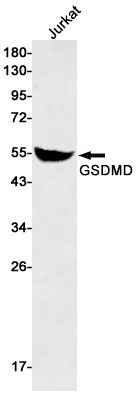
| WB | 1/500-1/1000 | Human,Mouse,Rat |
| IF | 咨询技术 | Human,Mouse,Rat |
| IHC | 咨询技术 | Human,Mouse,Rat |
| ICC | 技术咨询 | Human,Mouse,Rat |
| FCM | 咨询技术 | Human,Mouse,Rat |
| Elisa | 咨询技术 | Human,Mouse,Rat |
| Aliases | DF5L; DFNA5L; FKSG10; GSDMDC1 |
| Entrez GeneID | 79792 |
| WB Predicted band size | Calculated MW: 53 kDa; Observed MW: 53 kDa |
| Host/Isotype | Rabbit IgG |
| Antibody Type | Primary antibody |
| Storage | Store at 4°C short term. Aliquot and store at -20°C long term. Avoid freeze/thaw cycles. |
| Species Reactivity | Human |
| Immunogen | Recombinant protein of human GSDMD |
| Formulation | Purified antibody in TBS with 0.05% sodium azide,0.05%BSA and 50% glycerol. |
+ +
以下是3-4篇关于GSDMD抗体的关键文献摘要:
1. **文献名称**: *Cleavage of GSDMD by inflammatory caspases determines pyroptotic cell death*
**作者**: Shi J, et al.
**摘要**: 该研究首次揭示了GSDMD是炎性caspase(caspase-1/4/5/11)的底物,其切割后形成N端结构域介导细胞膜穿孔,导致焦亡(pyroptosis)和IL-1β释放,为GSDMD抗体的功能研究奠定基础(Nature, 2015)。
2. **文献名称**: *Caspase-11 cleaves gasdermin D for non-canonical inflammasome signalling*
**作者**: Kayagaki N, et al.
**摘要**: 研究证明caspase-11通过切割GSDMD触发非经典炎症小体通路,导致细胞焦亡和脓毒症病理,为开发靶向GSDMD抗体抑制过度炎症提供理论依据(Nature, 2015)。
3. **文献名称**: *GSDMD membrane pore formation constitutes the mechanism of pyroptotic cell death*
**作者**: Sborgi L, et al.
**摘要**: 通过结构生物学分析,揭示GSDMD-N端结构域形成跨膜孔隙的分子机制,为设计阻断GSDMD孔隙形成的治疗性抗体提供结构基础(EMBO J, 2016)。
4. **文献名称**: *A small-molecule inhibitor of gasdermin D blocks pyroptosis and protects from lethal septic shock*
**作者**: Rathkey JK, et al.
**摘要**: 研究开发了一种靶向GSDMD的小分子抑制剂,验证了GSDMD抗体在抑制焦亡和脓毒症中的潜在治疗价值(Cell Death Dis, 2017)。
**注**:以上文献均为GSDMD机制和抗体开发领域的里程碑研究,建议结合具体研究方向通过PubMed或Google Scholar获取全文。
The gasdermin D (GSDMD) protein is a key executor of pyroptosis, a lytic form of programmed cell death associated with inflammatory responses. GSDMD is activated through proteolytic cleavage by inflammatory caspases (caspase-1. -4. -5. or -11), which release its N-terminal pore-forming domain. This domain oligomerizes in cellular membranes, forming pores that disrupt ion gradients, induce cell swelling, and promote the release of pro-inflammatory cytokines like IL-1β and IL-18. GSDMD-mediated pyroptosis plays critical roles in host defense against pathogens and is implicated in inflammatory diseases, including sepsis, autoimmune disorders, and neurodegenerative conditions.
GSDMD antibodies are essential tools for studying these processes. They are widely used in techniques such as Western blotting, immunofluorescence, and flow cytometry to detect full-length GSDMD (∼53 kDa) and its cleaved active fragments (∼30 kDa N-terminal and ∼22 kDa C-terminal). Many antibodies target epitopes in the N-terminal domain to distinguish active forms or the C-terminal autoinhibitory domain to assess cleavage status. Some are designed to recognize caspase-specific cleavage sites (e.g., caspase-1 vs. caspase-11 cleavage in mice). Researchers rely on these antibodies to investigate GSDMD regulation in inflammasome activation, disease mechanisms, and therapeutic targeting. Validation using GSDMD knockout models is critical to confirm specificity, given homology with other gasdermin family proteins.
×